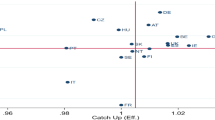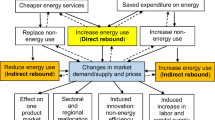Abstract
This paper describes the structure of a newly developed econometric, imperfectly competitive, general equilibrium model for the medium term study of energy and environmental problems. The geographical coverage of the model regards twelve European countries as well as the European Union as a whole. Compared to existing quantitative E3 (economy-energy-environment) models, the WARM model is characterized by a few novel and relevant features Firstly, in contrast to multicountry interlinked models, it copes with the international dimension by integrating differences from a common European denominator within a unified and homogeneously designed framework. A panel data estimation approach is used to achieve this objective. Secondly, in contrast to the traditional market-based philosophy of many econometric models, it adopts a perspective focused upon economic agents' decisions. Thirdly, in contrast with the practice of modelling technical progress as an exogenous and deterministic phenomenon, it incorporates an explicit attempt of modelling the sources and effects of endogenous technical change. A Kalman filter latent variable approach is the methodology from which statistical information on the dynamics of technical progress can be obtained. Finally, all markets in the model are imperfectly competitive, including the labour market where the wage bargaining process is explicitly modelled and estimated. This last feature is especially important in view of the European unemployment problem.
Similar content being viewed by others
References
E.R. Berndt and D.O. Wood, Energy price changes and the induced revaluation of durable capital in U.S. manufacturing, M.I.T. Sloan School Working Paper No. 1455-83 (1983).
O. Blanchard and S. Fischer,Lectures on Macroeconomics, MIT Press, Cambridge, 1989.
G. Boero, R. Clarke and L.A. Winters, The macroeconomic consequences of controlling greenhouse gases: A survey, Department of the Environment, Environmental Economics Research Series, HMSO, London, 1991.
L. Boone, S. Hall and D. Kemball-Cook, Endogenous technical progress in fossil fuel demand: The case of France, Center for Economic Studies Discussion Paper No. 21-93, 1992.
G. Bound and G. Johnson, Changes in the structure of wages during the 80's: An evaluation of alternative explanations. American Economic Review 82 (1992) 371–392.
G. Brunello, Labour market institutions and the double dividend hypothesis, in:Environmental Fiscal Reform and Unemployment, C. Carraro and D. Siniscalco (eds.), Kluwer Academic, Dordrecht, 1996.
J.M. Burniaux, J.P. Martin, G. Nicoletti and J. Oliveira Martins, The costs of reducing CO2 emissions: Evidence from GREEN, OECD Economics and Statistics Department Working Paper No. 115, 1992.
L. Calmfors and J. Driffill, Centralisation of wage bargaining and macroeconomic performance, Economic Policy 4 (1988).
L. Calmfors and A. Forslund, Real wage determination and labour market policies: the Swedish experience, Economic Journal 101 (1991) 1130–1149.
C. Carraro, New methods for macroeconomic policy analysis, unpublished Ph.D. Dissertation, Princeton University, 1985.
C. Carraro, Square root Kalman algorithms in econometrics, Computer Science in Economics and Management 1 (1988).
C. Carraro and M. Galeotti, WARM (World Assessment of Resource Management), Technical Report No. 94-01, GRETA Econometrics, Venice, 1994.
C. Carraro and M. Galeotti, Economic growth, international competitiveness and environmental protection: R&D and innovation strategies with the WARM model, Fondazione ENI Enrico Mattei Nota di Lavoro No. 29.95, 1995; forthcoming in Energy Economics.
C. Carraro and M. Galeotti, Environmental fiscal reforms in a federal Europe, in:Economic Aspects of Environmental Policy Making in a Federal State, J. Braden and S. Proost (eds.), Edward Elgar, Cheltenham, 1996.
C. Carraro, M. Galeotti and M. Gallo, Environmental taxation and unemployment: Some evidence on the double-dividend hypothesis in Europe, Journal of Public Economics 62 (1996) 141–181.
C. Carraro, Y. Katsoulacos and A. Xepapadeas (eds.),Environmental Policy and Market Structure, Kluwer Academic, Dordrecht, 1996.
C. Carraro and D. Siniscalco, The international dimension of environmental policy, European Economic Review 36 (1992) 379–387.
C. Carraro and D. Siniscalco, Environmental policy reconsidered: The role of technological innovation, European Economic Review 38 (1994), 545–554.
C. Carraro and A. Soubeyran, Environmental taxation, market-share, and profits in oligopoly, in:Environmental Policy and Market Structure, C. Carraro, Y. Katsoulacos and A. Xepapadeas (eds.), Kluwer Academic, Dordrecht, 1996.
W.R. Cline,The Economics of Global Warming, Institute for International Economics, Washington, DC, 1992.
K. Conrad and I. Henseler-Unger, Applied general equilibrium modeling for long-term energy policy in Germany, Journal of Policy Modeling 8 (1986) 531–549.
K. Conrad and M. Ehrlich, The impact of embodied and disembodied technical progress on productivity gaps — An applied general equilibrium analysis for Germany and Spain, Journal of Productivity Analysis 4 (1993) 317–335.
A.S. Deaton, Theoretical and empirical approaches to consumer demand under rationing, in:Essays in the Theory and Measurement of Consumer Demand, A.S. Deaton (ed.), Cambridge University Press, Cambridge, 1981.
A. Dobson, Multifirm unions and the incentive to adopt pattern bargaining in oligopoly, European Economic Review 38 (1994) 87–100.
Data Resources Inc. (DRI), The economic effects of using carbon taxes to reduce carbon dioxide emissions in major OECD countries, prepared for the U.S. Department of Commerce, 1992.
J.A. Edmonds, Long term modelling of the links between economics, technical progress, and environment: Evolution of approaches and new trends, mimeo, Pacific Northwest Laboratory, WA, 1992.
J.A. Edmonds and J. Reilly, Global energy and CO2 to 2050, Energy Journal 4 (1983) 21–47.
R. Freeman and R. Gibbons, Getting together and breaking apart: The decline of centralized collective bargaining, mimeo, 1993.
M.A. Fuss, The demand for energy in Canadian manufacturing, Journal of Econometrics 5 (1977) 89–116.
M. Galeotti, The intertemporal dimension of neoclassical production theory: A survey, Università degli Studi di Bergamo, Quaderni del Dipartimento di Scienze Economiche No. 13, 1994; forthcoming in Journal of Economic Surveys.
X.M. Gao, Measuring technological change using a latent variable approach, European Review of Agricultural Economics 21 (1994) 113–129.
M. Grubb, Improved models, paper presented at theFEEM-IPCC Conference on Top-Down vs. Bottom-Up Models, Milan 17–20 April, 1994.
M. Grubb, J. Edmonds, P. ten Brink and M. Morrison, The costs of limiting fossil-fuel CO2 emissions, Annual Review of Energy and Environment 18 (1993) 397–478.
A.C. Harvey, Applications of the Kalman filter in econometrics, in:Advances in Econometrics, T.F. Bewley (ed.), Cambridge University Press, Cambridge, 1987.
B. Holmlund and J. Zetterberg, Insider effects in wage determination, European Economic Review 35 (1991) 1009–1034.
C. Hsiao,Analysis of Panel Data, Cambridge University Press, Cambridge, 1986.
P. Jensen, Unemployment and minimum wages: A microeconometric analysis, mimeo, 1994.
D.W. Jorgenson and P.J. Wilcoxen, Intertemporal general equilibrium modelling of U.S. environmental regulation, Journal of Policy Modeling 12 (1990) 715–744.
P. Karadeloglou, Energy tax versus carbon tax: A quantitative macro-economic analysis with the HERMES-MIDAS models, European Economy, Special Edition No. 1, CEC-DGII, Brussels (1992).
H. Katz, The decentralisation of collective bargaining: A literature review and a comparative analysis, Industrial and Labour Relations Review 47 (1993).
S. Killingsworth and J. Heckman, Female labour supply: A survey, in:Handbook of Labor Economics, O. Ashenfelter and R. Layard (eds.), North-Holland, Amsterdam, 1986.
U. Kohli,Technology, Duality, and Foreign Trade, Harvester Wheatsheaf, Hemel Hempstead, 1991.
F. Krause, E. Haites, R. Howarth and J. Koomey, Cutting carbon emissions: Burden or benefit? The economics of energy-tax and non-price policies, International Project for Sustainable Energy Paths, El Cerrito, CA, USA, 1993.
R. Layard, R. Jackman and S. Nickell,Unemployment, Blackwell, Oxford, 1991.
L.J. Lau, A characterization of the normalized restricted profit function, Journal of Economic Theory 12 (1976) 131–163.
A.S. Manne and R. Richels, CO2 emission limits: An economic cost analysis for the USA, Energy Journal 22 (1990) 51–74.
A.S. Manne and R. Richels,Buying Greenhouse Insurance—The Economic Costs of CO 2 Emission Limits, MIT Press, Cambridge, 1992.
I.M. McDonald and R.M. Solow, Wage bargaining and employment, American Economic Review 71 (1981) 896–908.
F. Modigliani, Life cycle, individual thrift and the wealth of nations, American Economic Review 76 (1986) 297–313.
F. Modigliani and R. Brumberg, Utility analysis and aggregate consumption functions: An attempt at integration, in:The Collected Papers of Franco Modigliani, vol. 2, MIT Press, Cambridge, 1980.
K. Moene, Unions' threats and wage determination, Economic Journal 96 (1986) 98–109.
C.J. Morrison, Quasi-fixed inputs in U.S. and Japanese manufacturing: A generalized Leontief restricted cost function approach, Review of Economics and Statistics 70 (1988) 275–287.
J. Pencavel,Labour Markets under Trade Unionism, Blackwell, Oxford, 1991.
J.J. Rotemberg and M. Woodford, Energy taxes and aggregate economic activity, National Bureau of Economic Research Working Paper No. 4576, 1993.
M.E. Slade, Modeling stochastic and cyclical components of technical change: An application of the Kalman filter, Journal of Econometrics 41 (1989) 363–383.
J. Whalley and R. Wigle, Cutting CO2 emissions: The effects of alternative policy approaches, Energy Journal 12 (1990) 109–124.
D. Wilson and J. Swisher, Top-down versus bottom-up analyses of the cost of mitigating global warming, Energy Policy 21 (1993) 249–262.
Author information
Authors and Affiliations
Rights and permissions
About this article
Cite this article
Carraro, C., Galeotti, M. WARM: a European model for energy and environmental analysis. Environ Model Assess 1, 171–189 (1996). https://doi.org/10.1007/BF01874904
Received:
Revised:
Issue Date:
DOI: https://doi.org/10.1007/BF01874904




